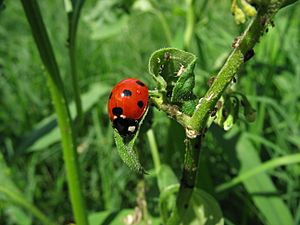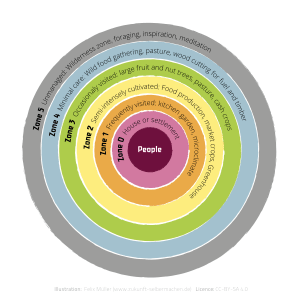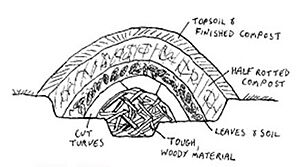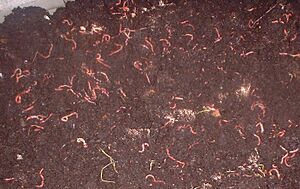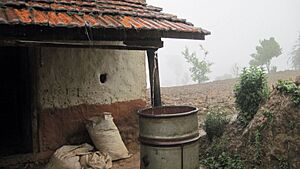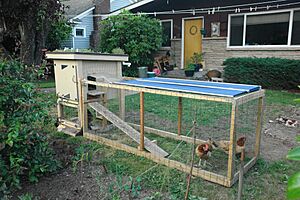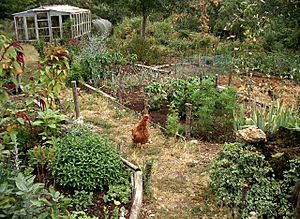Permaculture facts for kids
Permaculture is a smart way to design and manage land and homes. It uses ideas from how nature works, like how healthy forests grow. It's about creating systems that last a long time, just like in nature.
The word "permaculture" first meant "permanent agriculture." This was about growing food in a way that doesn't harm the Earth. Later, it also came to mean "permanent culture," including how people live together. Two people, Bill Mollison and David Holmgren, created the term in 1978. They wanted a different way of farming than the big, industrial methods. They looked back at older, more natural ways of growing food.
Permaculture includes many different areas. These include designing things that fit with nature, like buildings and gardens. It also covers how we manage water, build homes, and create places for plants and animals to thrive. All these systems are designed to be self-sustaining, just like natural ecosystems.
Permaculture uses creative design ideas. It involves thinking about everything that affects a project. For example, if you want to change how water flows, you think about what happens both upstream and downstream. You also consider how it will affect things now and in the future. If you see a "problem," like too many bushes, you think about how removing them might affect the soil and wildlife.
Some people have said that permaculture isn't always clear or scientific enough. They want more research to prove that it works well. They also want clearer ways to do it. Some critics think that many permaculture ideas don't help with real-world problems.
Contents
History of Permaculture
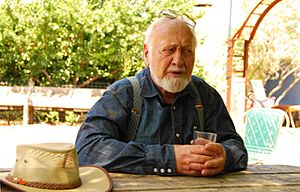
The idea of "permanent agriculture" has been around for a long time. In 1929, Joseph Russell Smith wrote a book called Tree Crops: A Permanent Agriculture. He saw how much land was being damaged by cutting down trees and plowing. He suggested planting fruit and nut trees to help the soil and water. He believed the world was connected and suggested mixing trees with other crops. His ideas inspired people like Toyohiko Kagawa in Japan, who started "forest farming" in the 1930s.
Another important figure was George Washington Carver. Starting in 1896, he developed practices that are now part of permaculture. He showed how rotating certain crops could put nitrogen back into the soil. This helped repair damaged farmland in the Southern USA.
In Australia, P. A. Yeomans wrote Water for Every Farm in 1964. He defined permanent agriculture as something that can last forever. He also created the Keyline Design. This was a way to manage water in dry areas. Other early influences include Ruth Stout and Esther Deans, who promoted "no-dig gardening." Masanobu Fukuoka in Japan also influenced permaculture. He promoted "no-till" farming and natural farming methods.
In the late 1960s, Bill Mollison and David Holmgren started working on ideas for stable farming systems. They were in Tasmania, Australia. They saw that modern farming methods were not sustainable. These methods used too many non-renewable resources. They also polluted land and water, reduced different types of life, and removed valuable topsoil. Mollison and Holmgren were inspired by traditional practices, including those of the Aboriginal people of Tasmania. They created permaculture as a solution. Their first book, Permaculture One, came out in 1978.
Permaculture is a philosophy of working with, rather than against nature; of protracted and thoughtful observation rather than protracted and thoughtless labor; and of looking at plants and animals in all their functions, rather than treating any area as a single product system.
—Bill Mollison
After Permaculture One was published, many people were excited about permaculture. Mollison started traveling and teaching a three-week program called the Permaculture Design Course (PDC). This course taught people how to apply permaculture design to different climates and soils. It also covered using renewable energy and natural building methods. Mollison taught in many countries, and his students went on to become teachers themselves.
By the early 1980s, permaculture grew beyond just farming. It started to include creating sustainable places for people to live. Mollison continued to develop his ideas. In 1988, he published his big book, Permaculture: A Designers Manual. He taught hundreds of students and encouraged them to become teachers and set up their own permaculture sites.
In the 1990s, permaculture spread even further. Institutes were set up in Asia, Africa, and the Americas.
Core Ideas of Permaculture
Permaculture is built on three main ethical principles:
- Care of the Earth: This means making sure all living things can continue to live and grow.
- Care of people: This means making sure everyone has what they need to live.
- Setting limits to population and consumption: This means managing our own needs. By doing this, we can save resources for the future and share what we have.
Permaculture focuses on how things are arranged in a landscape. It looks at how different parts of an ecosystem work together. The goal is to place elements so they help the local environment the most. Permaculture tries to connect things in useful ways. This creates a system where the whole is much better than just its individual parts. It also aims to reduce waste, hard work, and energy use.
Permaculture designs copy patterns found in nature. These patterns have worked well for thousands of years. So, permaculture designs will look different depending on where they are in the world. This is because each place has its own unique natural patterns. Permaculture uses ideas from many fields. These include organic farming, sustainable development, and the study of how ecosystems work.
Permaculture Theory
Design Principles
David Holmgren wrote about twelve key permaculture design principles. These are like guidelines for creating sustainable systems:
- Observe and interact: Spend time watching nature to create solutions that fit your specific place.
- Catch and store energy: Create systems that collect resources when they are plentiful. Then you can use them when you need them.
- Obtain a yield: Focus on projects that give you useful results, like food or energy.
- Apply self-regulation and accept feedback: Learn from what happens and make changes. This helps systems work well.
- Use and value renewable resources and services: Make the most of what nature provides. Reduce how much you use non-renewable resources.
- Produce no waste: Use everything you can. Don't throw things away.
- Design from patterns to details: Look at big patterns in nature and society first. Then, add the smaller details to your designs.
- Integrate rather than segregate: Design things so different parts work together and support each other.
- Use small and slow solutions: Smaller systems are easier to manage. They also use local resources better and last longer.
- Use and value diversity: Having many different things makes a system stronger. It also helps it use its environment fully.
- Use edges and value the marginal: The places where different things meet are often the most interesting and productive. Think of a coastline where land and sea meet.
- Creatively use and respond to change: Change is always happening. By watching carefully, you can make positive changes at the right time.
Layers in a Permaculture Garden
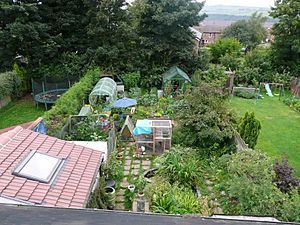
Layers are a way to design healthy ecosystems that help humans. A natural ecosystem has many parts, like trees, smaller plants, soil, and animals. Because plants grow to different heights, many different living things can live in a small space. Forests often have seven main layers:
- Rhizosphere: This is the root layer under the soil. It includes plant roots, fungi, insects, and worms.
- Soil surface/groundcover: Plants here grow close to the ground. They cover bare spots and help protect the soil.
- Herbaceous layer: These are plants that die back in winter but don't have woody stems. Many herbs are in this layer.
- Shrub layer: These are woody plants that are not too tall, like berry bushes.
- Understory layer: These are trees that grow well under taller trees.
- Canopy: This is the top layer of the tallest trees.
- Vertical layer: These are climbing plants or vines, like beans, that grow upwards.
Plant and Animal Guilds
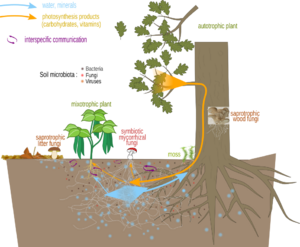
A guild is a group of different plants, animals, or insects that help each other. They work together to make the ecosystem healthier. For example, some plants might bring nutrients from deep in the soil. Others might add nitrogen to the soil. Some attract helpful insects, while others keep pests away.
There are different types of guilds:
- Community function guilds: These groups of species perform a specific job in the garden. For example, plants that attract helpful insects or plants that put nitrogen back into the soil.
- Establishment guilds: These are used to help new plants grow. For example, you might plant comfrey (to block weeds) and lupine (to add nitrogen) around a young fruit tree.
- Mature guilds: These form once your main plants are grown. For example, if a tree grows tall and shades out sun-loving plants, you can plant shade-loving herbs underneath it.
- Mutual support guilds: These groups of species directly help each other. For example, mycorrhizal fungi help plant roots get minerals and nitrogen, and in return, the plants give the fungi sugars.
- Resource partitioning guilds: These groups share resources by using them in different ways. For example, a plant with shallow roots might grow next to a plant with deep roots. This way, they get nutrients from different soil levels.
Edge Effect
The edge effect happens where two different environments meet. Permaculturists believe these "edges" are very productive. For example, where land meets the sea, there's a lot of life and resources. In permaculture design, this idea is used by making wavy pond edges or spiral herb gardens. This increases the "edge" area, making them more productive.
Zones in Permaculture Design
Permaculture uses "zones" to organize different parts of a design. This is based on how often people use them and what plants or animals need. Things that need a lot of attention are placed close to the house. Things that need less attention are placed further away. Zones are numbered from 0 to 5:
- Zone 0: This is the house or home center. Here, permaculture aims to reduce energy and water use. It uses natural resources like sunlight to create a comfortable, sustainable living space.
- Zone 1: This zone is closest to the house. It's for plants that need daily care, like salad greens, herbs, and strawberries. Greenhouses and compost bins for kitchen waste are also here.
- Zone 2: This area is for plants that need less frequent care, like berry bushes and fruit trees. It's also a good place for beehives and larger compost bins.
- Zone 3: This is where main crops are grown for food or to sell. Once established, these plants need less care, maybe just watering once a week.
- Zone 4: This is a semi-wild area. It's used for collecting wild plants and growing trees for wood.
- Zone 5: This is a wilderness area. Humans don't interfere here, except to observe nature. This zone helps the other zones by providing a natural home for helpful insects and organisms.
Common Permaculture Practices
Agroforestry
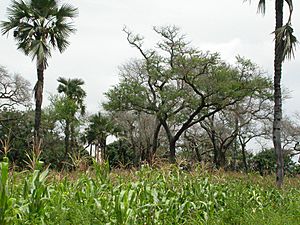
Agroforestry is about growing trees and shrubs with crops or animals. It mixes farming and forestry to create more diverse and productive land. Trees or shrubs are intentionally planted within farming systems. This helps create healthier and more sustainable land use.
Forest gardening or food forests are systems that copy natural forests. They use the natural processes and relationships found in healthy ecosystems. People like Graham Bell and Geoff Lawton have promoted these ideas.
Suburban and Urban Permaculture
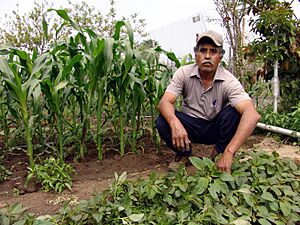
In cities and suburbs, permaculture focuses on using space wisely. It's important to grow as much food as possible in a small area. Methods like the keyhole garden help with this. Neighbors can also work together to make bigger changes. Places like community centers and schools can become part of a larger movement. For example, in Portland, Oregon, a community called Columbia inspired neighbors to create front-yard gardens.
Sometimes, empty lots in cities are turned into community gardens. However, these gardens are sometimes seen as temporary. This can be a problem because permaculture is about creating permanent systems. For example, the South Central Farm in Los Angeles was a very large urban garden. It was eventually closed down, even though the community had worked hard to create it.
Hügelkultur
Hügelkultur is a practice where wood is buried to help the soil hold water. The wood acts like a sponge as it breaks down underground. During rainy times, enough buried wood can soak up water to help plants survive through dry periods. This is an old technique from Europe that permaculturists now use.
You can build Hügelkultur mounds on the ground or in raised garden beds. In raised beds, you place wood (like logs and sticks) at the bottom. Then, you pile soil and compost on top. This helps the soil structure and drainage. Studies show that Hügel beds need less watering over time.
Vermicomposting
Vermicomposting is a common permaculture practice. It uses earthworms, like red wigglers, to break down food scraps and other organic waste. The worms produce "worm castings," which are like super-rich fertilizer for gardens. Worms also help loosen the soil and improve how it holds water. Worms can multiply very quickly if they have good conditions.
Natural Building
Natural building uses building methods and materials that follow permaculture ideas. The focus is on making strong buildings that last. It uses materials that are natural, easy to find, or recycled. These materials also help create healthy indoor spaces. For example, cement production can harm the environment. Natural building uses materials like cob (a mix of clay, sand, straw, and water), adobe, or straw bales. These materials are biodegradable and can insulate homes very well.
Natural building tries to reduce the environmental impact of buildings. It uses materials like clay, rock, sand, straw, and wood. It also uses traditional building ideas from different climates. Buildings are often designed to be compact. They also try to handle energy, water, and waste on-site. Many materials are sourced from nearby areas. Roofs often have plants growing on them, called "living roofs."
Rainwater Harvesting
Rainwater harvesting is collecting and storing rainwater before it runs off. This water can be used for drinking, for animals, or for watering plants. Collecting rainwater from roofs can help provide drinking water. It can also help replenish underground water sources and make cities greener.
Greywater is water from things like laundry, dishwashing, and bathing. This water can be reused for watering gardens or in special plant-based water filters. Greywater is different from "blackwater," which contains human waste. In permaculture, human waste can be composted through a process called "humanure." The gas from humanure can even be collected and used as fuel, like for heating or cooking.
Domesticated Animals
Animals are often part of permaculture designs. They are very important for a healthy ecosystem. Animals can help by:
- Finding food and spreading nutrients.
- Cleaning up fallen fruit.
- Helping with weed control.
- Spreading seeds.
- Controlling pests.
Animals turn less digestible things, like grass, into nutrient-rich manure. Chickens, for example, can scratch the soil, breaking it up and adding their waste as fertilizer. It's important to remember that animals need daily care, more than plants do.
Sheet Mulching
Mulch is a protective layer placed over the soil. It can be made of stones, leaves, wood chips, or cardboard. In permaculture, organic mulches are preferred because they do many things. They absorb rain, reduce water evaporation, add nutrients to the soil, and create homes for soil organisms. They also help stop weeds, protect against frost, and reduce soil erosion.
Sheet mulching is a gardening technique that copies how natural forests work. It's like the layer of leaves found on a forest floor. When done correctly, it can create healthy, productive gardens that need less work. Sheet mulch acts like a "nutrient bank." It stores nutrients from organic matter and slowly releases them to plants as it breaks down. It also improves the soil by attracting earthworms and other helpful organisms. Earthworms "till" the soil, and their castings are excellent fertilizers. Sheet mulching can also help get rid of unwanted plants by blocking their light.
Grazing

Grazing animals are sometimes blamed for damaging land. However, when grazing is done like it happens in nature, it can be very helpful. Cell grazing is a system where animals are regularly moved to fresh areas. This helps maximize the quality and quantity of the plants they eat. People like Sepp Holzer and Joel Salatin have shown how grazing can help new ecosystems start or prepare land for planting. This is sometimes called "conservation grazing." Here, the main goal is to help the environment, not just to produce meat or milk. For example, sheep can be used instead of lawnmowers, and goats can eat invasive plants.
Keyline Design
Keyline design is a technique for making the best use of water. It was developed in Australia by P. A. Yeomans. A "keyline" is a special contour line on the land. Plowing along and around this line helps direct water away from just flowing downhill. This reduces erosion and helps water soak into the ground. It's used to design smart drainage systems.
Fruit Tree Management
Some permaculture experts suggest very little pruning for fruit trees. Sepp Holzer used this method. He grew fruit trees at very high altitudes where they normally wouldn't survive. His special mounds (Hügelkultur) kept the roots warm enough in winter. He noted that unpruned branches bend under snow, forming a natural arch that protects the tree.
Masanobu Fukuoka also experimented with not pruning trees in Japan. He found that letting trees grow completely wild could make them unhealthy. He learned that trees should be raised without pruning from the start. This allows them to form natural, healthy branch patterns. He believed this "no-action" approach, or "do-nothing" farming, could lead to yields as good as or better than traditional methods.
Marine Systems
Permaculture started with farming on land, but its ideas can also be used in the ocean. This is called marine permaculture. One example is creating "artificial upwelling." This brings cold, deep ocean water to the surface. This water is rich in nutrients. When you add a place for kelp to attach, a kelp forest can grow. Kelp needs the cool water and nutrients. Tiny algae also grow.
Kelp forests are great habitats for many fish. Kelp itself is a renewable resource. It can be used for food, animal feed, medicines, and other products. It also helps remove carbon from the atmosphere. This artificial upwelling can be powered by renewable energy. Marine permaculture helps restore important ocean ecosystems that have been damaged by warming waters.
Criticism of Permaculture
Some people criticize permaculture for not being clearly defined or scientific enough. They want more research to prove its claims and to make its methods clearer. Peter Harper from the Centre for Alternative Technology thinks that much of permaculture doesn't help with real problems.
Supporters of permaculture say that it's not yet a big scientific field. They point out that it doesn't have the same resources as large industrial agriculture. They also suggest that mainstream science sometimes favors big corporations.
Aquaculture
Some critics, like Nick Romanowski, believe that the way aquaculture (farming in water) is presented in some permaculture books is not realistic.
Agroforestry
Greg Williams argues that forests cannot be more productive than farmland. He says that as forests get older, their overall productivity goes down. Permaculture supporters respond that this is only true when comparing very old forests to farmland. They say that productivity generally increases until a forest reaches a certain level of tree cover.
See also
 In Spanish: Permacultura para niños
In Spanish: Permacultura para niños
- Agrarianism
- Agroecology
- Aquaponics
- Biochar
- Biodynamic agriculture
- Biointensive agriculture
- Climate-friendly gardening
- David Holmgren
- Food-feed system
- Forest gardening
- Geoff Lawton
- Holzer Permaculture
- Microponics
- Natural farming
- Namul
- Paul Wheaton
- Regenerative agriculture
- Seed saving
- Sepp Holzer
- Zaï



